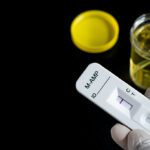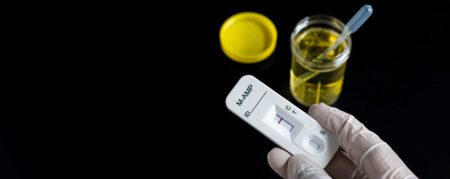


Role of Drug Test Cups in Efficient Random Testing Programs
October 4, 2023


Drug Testing in Schools: A Guide to Effective Implementation
October 5, 2023How Long Do Drugs Stay in the System? is a complex topic that carries significant implications for both individuals and society.
The science behind drug detection can seem daunting, yet it's crucial to grasp this knowledge.
Different types of drugs have varying detection windows. Many elements can impact the period of detection for different drugs, such as metabolic rate, BMI (body mass index), age and more.
In essence, How Long Do Drugs Stay in the System? equips you with vital information on how long substances stay detectable in your system after use.
Drug Detection Windows: Overview
In the realm of drug testing, understanding "drug detection windows" is crucial. These windows represent the timeframe during which a substance or its metabolites can be detected in an individual's body post-consumption.
The Lifespan of Drugs within Our System
Common drugs, including marijuana, may linger for days to weeks, while synthetic substances like crystal meth are generally eliminated from our system more swiftly. Generally speaking, most illicit substances have short half-lives, but some with longer half-life might remain traceable over a long period.
Detection Methods & Their Timeframes
Varying test methods offer different detection times. Urine tests are common due to their ability to spot many types of substances 1-4 days after administration, whereas hair follicle tests provide an extended window up until 90 days, albeit requiring high doses before they become effective at detecting usage.
- Saliva Tests - Typically detects recent use within 24-48 hours only.
- Blood Testing - Less commonly used because it has a narrow window; however, it can determine both presence and approximate quantity, making it useful when assessing immediate impairment or intoxication levels.
Synthetic Substances & Unique Challenges They Present
Synthetic opioids, along with synthetic marijuana, pose unique challenges owing to their complex chemical structures that often dodge standard detections offered by urine testing kits. The ever-changing composition makes these designer drugs not just difficult to identify but also estimate how long they will stay traceable in one's system, thus emphasizing the importance of evolving advanced testing techniques to keep pace with the changing nature of the substance abuse landscape today.
Drug Types and Detection Times
The type of drug influences the period in which it can be detected by various testing methods. Each substance has its unique timeframe within which it can be detected through various testing methods.
Detection Windows for Common Drugs
Marijuana: The period marijuana stays detectable varies depending on usage frequency, with occasional users clearing out faster than heavy users. In urine tests, THC metabolites may remain traceable from three days to over 30 days.
Synthetic Marijuana: Known as K2 or Spice, the detection times for synthetic marijuana are unpredictable due to varied compositions. Standard drug tests usually pick up traces within three days post-use.
Cocaine: While cocaine is eliminated quickly by the body after administration, its metabolite - benzoylecgonine - remains detectable in urine for two to three days.
Opioids and Methamphetamines: Understanding Their Stay Periods
In the case of opioids like hydrocodone and oxycodone, commonly prescribed substances stay detectable via standard urine tests between two to four days. Synthetic opioid fentanyl follows a similar pattern, but certain analogues could have longer half-lives, leading them to linger longer in your system. Crystal meth, another illicit substance that is frequently abused, generally leaves one's system quickly, yet high doses might lead to a five-day long presence.
Hallucinogens & Prescription Medications: Tracing their Presence
LSD, an extremely potent hallucinogen, exits our systems rapidly, often making it challenging to trace using standard drug tests unless done soon after ingestion. Benzodiazepines vary greatly based on whether they are short-acting ones such as Xanax (gone within a few days) versus long-acting ones like Valium (could last weeks). Prescription medications depend heavily on the specific medication type, dose size, frequency, etc.
Factors Affecting Detection Times
The detection window for drugs varies based on several factors. Understanding these variables is crucial when interpreting drug test results.
Influence of Metabolism Rate
A person's metabolic rate significantly impacts how long drugs stay in their system. The metabolism process breaks down substances, including illicit ones like crystal meth or commonly prescribed medications. Those with faster metabolisms typically eliminate drugs from their systems more quickly than those with slower rates.
Role of Body Mass and Fat Content
An individual's body mass and fat content also affect the duration that a substance stays detectable within the system. Drugs often find storage spaces in fatty tissues; hence individuals possessing higher percentages of body fat may retain certain substances longer compared to those having lower amounts of body fat. Studies show this correlation between body composition and drug retention times.
Dosage & Frequency Impacts
The dosage level and frequency at which a substance is used can greatly influence its detection period. High doses or frequent use can lead to an accumulation within one's bodily fluids, thereby extending standard drug tests' ability such as urine testing or hair follicle tests to detect it over time. Research supports this claim, indicating increased usage correlates directly with prolonged detection windows.
Type Of Drug Matters Too.
Different types of drugs have varying half-lives which affect how long they remain traceable within your system after administration. For instance, synthetic marijuana might leave your system swiftly due to its shorter half-life while other substances like synthetic opioids possess a longer half-life, thus staying identifiable for an extended period. Scientific studies back up this notion, highlighting different elimination periods among various kinds of drugs.
Effects of Age and Health Status on Detection Times
Your age along with your overall health status play pivotal roles too. Older adults generally take longer to metabolize substances because liver function slows down as we age.
Urine Testing
When it comes to standard drug tests, urine testing is a frequently utilized method for detecting illicit substances. The time frame in which drugs stay detectable via these tests can vary widely due to factors such as the specific type of drug, frequency of use, and individual metabolic rates.
Dynamics of Urine Testing
The procedure typically involved in urine testing includes obtaining a sample from an individual and then dispatching it to a lab for evaluation. Some instances may yield immediate results with onsite kits that do not require lab processing.
This form of test operates by identifying metabolites - these are essentially residues produced when the body breaks down drugs. Interestingly enough, these metabolites linger on within your system long after you've ceased feeling any effects from the substance itself.
Detection Windows: A Closer Look
The length at which different types of drugs remain detectable through urine tests varies significantly based on their unique properties. For instance, marijuana could potentially be detected up until 30 days post-consumption, whereas synthetic opioids like fentanyl typically become undetectable roughly 72 hours following usage.
Stimulants including crystal meth or cocaine usually leave traces that can be found anywhere between two and four days subsequent to administration, but habitual users might display longer detection times due to built-up residue over extended periods.
Potential Limitations & Advantages Associated With Urine Tests
In spite of being effective at pinpointing recent cases involving common substance abuse like cannabis or amphetamines, one notable limitation is its inability to accurately measure levels regarding purity or dosage consumed.
However, their non-invasive nature coupled with relatively low costs makes them popular among companies conducting routine employee screenings.
Moreover, certain compounds including synthetic marijuana often evade blood tests but still get picked up during comprehensive urinalysis procedures, making this method quite versatile despite the aforementioned limitations.
Hair Testing: A Comprehensive Guide
When it comes to assessing drug use, hair follicle testing stands out for its ability to identify substance consumption over a lengthy timeframe. This technique involves the analysis of a small sample of hair for signs of illicit substances or commonly prescribed drugs.
Detection Windows and Substances Identified
The detection window offered by hair tests is significantly more extensive than other standard drug tests such as urine or saliva. Generally speaking, these assessments can pinpoint substance abuse that took place up to 90 days prior, depending on the individual's hair length. However, this test may not be effective in detecting recent drug use due to the time taken for drugs to stay incorporated into one's system via their scalp.
In terms of what substances are identifiable through this method: common drugs like marijuana stay detectable alongside synthetic opioids and synthetic marijuana, among others. Even high doses from legally administered medications could potentially yield positive results if misused.
Procedure Followed & Accuracy Level
A trained technician usually collects a tiny sample close to the scalp where growth is most current. The collected samples undergo rigorous laboratory scrutiny, often involving two stages - preliminary screening followed by confirmatory testing using sophisticated techniques like gas chromatography/mass spectrometry (GC/MS).
When compared with other types of screenings such as urine tests, hair follicle testing has gained popularity owing to its accuracy level coupled with the difficulty levels involved while attempting cheat methods aimed at eliminating traces quickly from systems or avoiding detection altogether, which might work otherwise in the case of urine samples.
Limits & Considerations Involving Hair Tests
Naturally, there are certain limitations associated with any form of procedure, including those pertaining specifically towards conducting successful outcomes during the application process under consideration here, namely 'Hair Follicle Test'. Factors ranging across natural differences occurring within individuals related directly affecting the rate at which hairs grow, eventually impacting upon how long a specific type of chemical compound remains traceable inside a person's body, especially when comparing between someone who possesses slow-growing hairs against another whose ones tend to develop faster comparatively, thereby showing longer half-life times respectively.
Saliva Testing
Among the common drug tests, saliva testing or oral fluid testing stands out for its unique advantages. It's a popular method for detecting drugs and their metabolites present within an individual's system.
Detection Window of Saliva Tests
The detection window for substances using saliva tests can vary widely based on the type of drug used. For instance, research suggests that cannabis may only be detectable up to 24 hours after use, while cocaine might remain traceable around two days post-consumption.
Synthetic opioids such as fentanyl are typically detected within one day following usage, whereas methamphetamines and ecstasy could show positive results anywhere from one to four days later. This variability underlines how long drugs stay identifiable through this mode of screening.
Balancing Advantages with Limitations
A notable benefit provided by saliva testing is its ability to accurately pinpoint recent substance abuse. It effectively eliminates opportunities that individuals might exploit to tamper with samples due to direct supervision during the collection process. This makes it less intrusive compared to other methods like blood or hair follicle tests, which require more invasive procedures. Consequently, saliva testing is easier administratively overall.
Blood Testing: A Comprehensive Guide
Blood testing is an essential part of managing substance abuse, as it can accurately identify both illegal drugs and commonly prescribed medications shortly after ingestion. It quickly detects both illicit substances and commonly prescribed medications after consumption.
Detection Window in Blood Tests
The detection window varies significantly depending on factors such as drug type, dosage level, frequency of use, and individual metabolic rates. For instance, marijuana stays detectable up to 36 hours post-consumption, while synthetic opioids or crystal meth may linger longer due to their extended half-life.
Frequent administration or high doses can further extend these windows considerably. Research shows that drugs with long half-lives tend to remain detectable much longer than those with shorter ones.
Potential Advantages & Limitations
Sensitive and precise measurement capability makes blood tests highly effective at determining drug purity levels within minutes following consumption. They're particularly beneficial when recent substance misuse is suspected or immediate results are needed during emergencies.
However, despite its accuracy, there are limitations associated with this method too. The invasive nature of drawing blood often leads individuals to prefer non-invasive alternatives like saliva tests or urine testing, which cause less discomfort upon administration.
Avoiding Detection: Myth vs Reality?
- Certain detoxifying products claim they speed up elimination but lack scientific backing. Evidence suggests most attempts at accelerating elimination don't significantly alter how long drugs stay in an individual's system nor affect test outcomes positively.
- In contrast, some believe consuming large amounts of water might help dilute traces of substances; however, this approach has limited effectiveness, especially against comprehensive screens where other markers will indicate tampering.
- Misconceptions about quick fixes abound, but remember - prevention trumps cure every time when it comes down to potential issues related to substance misuse.
FAQs in Relation to How Long Do Drugs Stay in the System?
How long does it take for a drug to be eliminated from the body?
The elimination time varies based on the type of drug, metabolism rate, and individual health factors. It can range from a few hours to several weeks.
How many days can a drug test detect drug use?
A standard urine test typically detects drugs used within the past 2-7 days. However, detection times may vary depending on the substance and frequency of usage.
How long can a urine drug screen sit?
A urine sample should ideally be tested within two hours of collection. If necessary, it could be stored in refrigeration for up to 48 hours, but this is not recommended due to potential changes in results.
How far back does a 10-panel urine test go?
A typical 10-panel urine test usually identifies substances consumed within the last week. However, certain drugs like marijuana might be detected even after several weeks if use was heavy or chronic.
Conclusion
How Long Do Drugs Stay in the System? It's a captivating exploration into the realm of drug testing.
We've explored different types of drugs and their detection times, shedding light on how long substances linger in our bodies.
We delved into factors that can influence these detection windows - from metabolism rate to body mass index, age, and more.
You learned about various testing methods including urine, hair, saliva, and blood tests. Each has its unique advantages for detecting specific substances.
This knowledge is not just scientific trivia; it holds real-world implications for individuals undergoing drug tests or professionals conducting them.
Ready to take your understanding further?
With our wide range of resources and expertise, we can help you put this knowledge into practice effectively.





